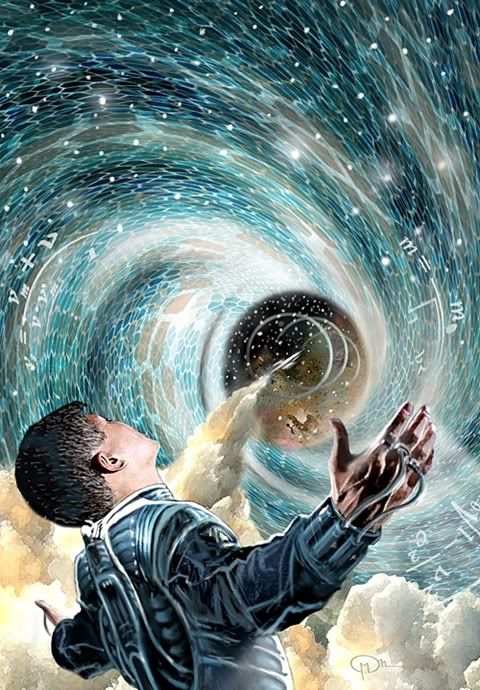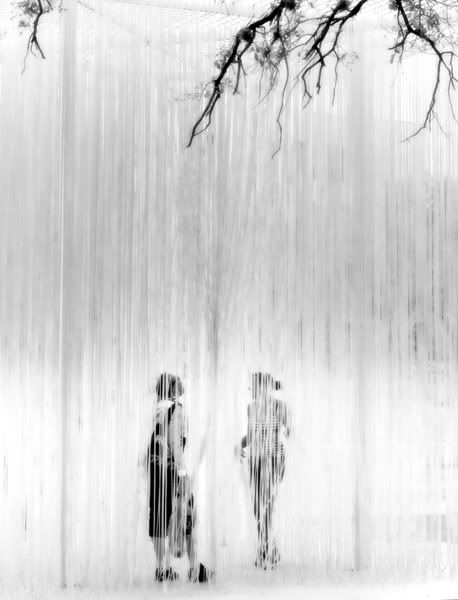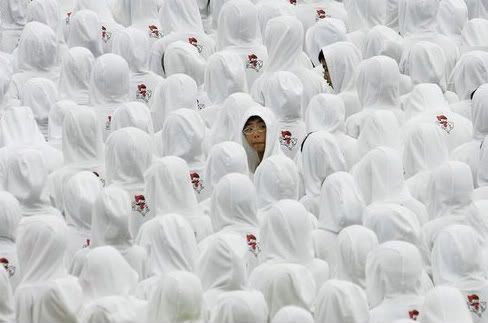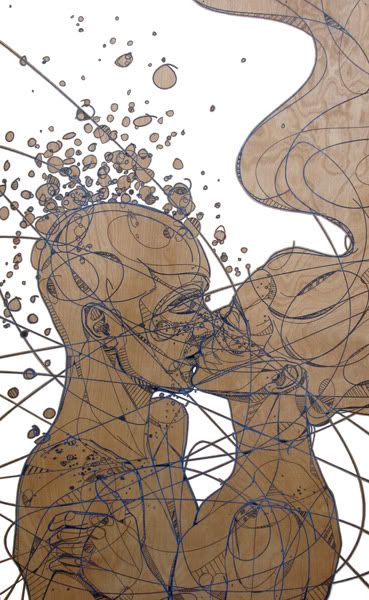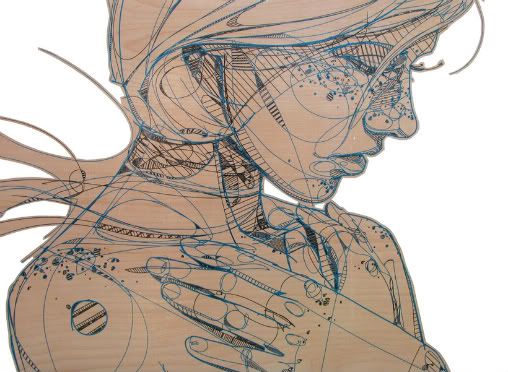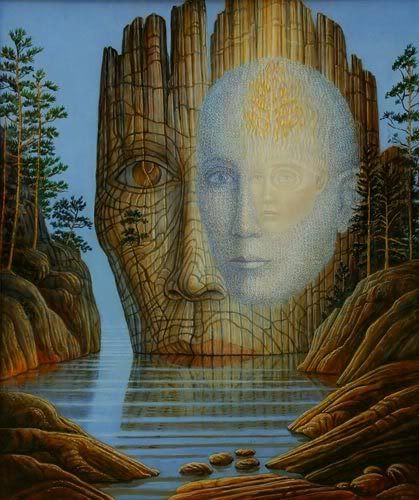
Re-Connection vs Re-Collection
by
Maureen B. Roberts, PhD
We shall not cease from exploration
And the end of all our exploring
Will be to arrive where we started
And know the place for the first time.
{T.S. Eliot}
Individuation & Soul Retrieval as Remembered Wholeness
Individuation, or becoming a whole individual through self-realization, as an ongoing journey involves a natural "re-collection", re-gathering, or Platonic anamnesis (remembrance) of an innate wholeness and centre, the Self. The aim of personal individuation is the reproduction of this unity, the Original Being, who in Platonic thought was a sphere. This concept of the androgynous Original Being, then, represents both the origin and goal of psychic wholeness, a wholeness which is lost, or forgotten when through the emergence of the ego we fall from an original state of innocence into a state of conflict. This division, or "dis-ease" is in turn resolved through the restoration of psychic harmony in a reclaimed "higher innocence" of conscious centredness in the Self.
Individuation as Re-Collected Unity
At the heart of Neoplatonism, a forerunner of Jungian 'gnosis', is the assumption of an a priori knowledge grounded in archetypal forms and aimed toward a unification of the ultimate principle of "the One", or "The Simple" with the diverse phenomena of "the Many". In the same way as in Neoplatonic thought the Many are resolved through self-reflective synthesis into the One, so psychic opposites become individuated into and through the Self. Since the Platonic Ideas are also the basis of an innate self-knowledge, through anamnesis acquired knowledge is the recovery of what was once possessed in a precarnate existence in the realm of transcendent Forms, an assumption which underlies the Romantic poet Wordsworth's claim that:
Our birth is but a sleep and a forgetting:
The soul that rises with us, our life's Star,
Hath had elsewhere its setting,
And cometh from afar...
As a natural centring and unfolding of the personality, individuation is an alchemical cycle of separation and synthesis which involves the dethroning, or relative abolition of the ego. This mythic process takes place through the gradual distillation of the Self - the ambivalent archetypal core of the personality - out from a latent condition of unconsciousness into its rightful place at the centre of consciousness. Individuation is a lengthy process, indeed one which once begun, never ends, for becoming centred in the Self is merely the starting point of a new journey which, like the Medicine Wheel, moves outward in an ever-widening spiral to embrace the fate and soul of World and Cosmos.

Re-Connecting to World Soul
What, then, is the nature of this 'soul' that needs to be retrieved, not only for the individual but ultimately for the world as the anima mundi whose children we all are? Is the 're-connection' with soul the same as the 're-collection' of Self that underscores the individuation process?
If, as Jung made clear, individuation does not shut one out from the world but gathers the world to oneself, so soul-making gathers the individual to all-pervasive soul, anima mundi expanding into the even more inclusive sphere of unus mundus. In this interweaving waltz, through the Dionysian explosion of the isolated ego, soul's diffusive movement outward meets soul's infusive movement from outer to inner, and the two merge in an imaginal Cosmos, whose Centre, as all shamans know (through imaginal 'gnosis'), is everywhere
If "soul" refers also to an anima mundi, a world soul, then as alchemists such as Paracelsus stated, the soul in one sense lies beyond the individual and belongs to a mode of reality beyond our control. In the Neoplatonic Fourth Ennead, Plotinus discusses whether all individuals are one soul, while the merging of individual and universal Tao is, as the alchemist Gerhard Dorn noted, the third degree of the alchemical coniunctio, the most mature phase of individuation as the realization of one's communion with an original unitary reality, what Jung describes as 'the eternal Ground of all empirical being.' As a mode of consciousness, such re-collection is grounded in the intuition of a centred sphere of soul, a microcosm which through the alchemical dictum "As Above, so Below", mirrors the outer macrocosm of Cosmos.
Therapy as Soul Mythos & Pathos
An appreciation of the complementarity of individuation as 're-collection', and Soul-making as 're-connection' to World Soul, has vital repercussions in the arena of psychopathology. James Hillman has undoubtedly contributed more than anyone in the post-Jungian camp to stressing our need to honour the Dionysian, or 'dis-integrating' dimension of therapy. Conversely, positive thinking - as a psychological theory - assumes that anything that's broken, or off-centre (eccentric!), or suffering, or in darkness, depression, neurosis, or symbolic death needs to be immediately fixed up, centred, unified, or brought into the light of health.
As Hillman notes, there is a soul-world of difference here between 'spiritual discipline' and therapy. As he puts it: 'Anyone who tends to dismiss pathology for growth, or anima confusions for ego strength and illumination, or who neglects the differentiation of multiplicity and variety for the sake of unity is engaged in spiritual discipline.' Therapy, on the other hand, concerns itself with 'soul' which, as Hillman stresses, is inherently pathological, multiple, prone to wandering, death, depth and depression.
An awareness of the potential value of pathology is accordingly essential in psychotherapeutic practice. If we understand therapy as (literally) 'a service to the gods' who inform soul, then we need, firstly, to avoid the trap of assuming that reintegration is tantamount to elevating psychic unity over plurality, or that an absence of 'dis-ease' is in all instances helpful, necessary, or appropriate to the mythic context of the pathological state. Reintegration, at least in my understanding of it, amounts to re-establishing a conscious relationship between fragmented soul-parts, or splinter personalities. It does not necessarily mean annihilating these splinter psyches, or otherwise merging them into one at the expense of the many. Hence to denigrate dis-integration as in all instances undesirable is to privilege the still centre of the mandala over the tension of opposites at the circumference; it is to promote monotheism above the soul's need for a plurality of gods, to elevate the pristine heights of spirit, as an archetype of unity, over the soul's need for immersion and dispersion in the human sufferings of the vale. And it is to set god against god, Apollonian simplicity against Dionysian multiplicity, reason over divine madness, order over chaos, focus over radiation, coagulation over dissolution. Individually, the gods, after all, are just as likely to be found in one camp as in the other.
The re-connection with soul, then, is not equivalent to the re-enthroning of the monotheistic myth of psychic unity, but is rather on one level the reinstatement of soul in all its imaginal complexity and fragmentation, its meanings and meanderings; for if the psyche protects against splintering, it is also prone to splintering its protection. Perhaps, in other words, we need to 're-vision' soul retrieval by viewing it not only as a reintegration of the personality, but also as an affirmation of polytheistic soul that is at the heart of the "I-Thou" of human and Cosmic life. If soul is both one and many, then the centripetal re-connection to multiple soul compensates the centrifugal re-collection of an original unity of soul.
Just as shamans, through initiation death-rebirth must heal themselves, so the effective depth therapist is one who through individuation as the ongoing "re-collection" of wholeness, has transcended the "dis-ease" of imbalance and conflict by becoming consciously centred in the Self rather than in the one-sided ego. This re-centring does not obliterate conflict, multiplicity of soul, or pathology, but rather allows for the coexistence of a more central and detached vantage point from where an untouchable core of the personality serenely views the conflict, while the pathologizing soul is unavoidably immersed in it. Our wounds, after all, parent our destinies and keep us in the body - and in the world. They stop us from the temptation to escape upward along the vertical axis of "spirit" and keep us anchored instead in the World, hence along the horizontal human axis of Keatsian "Soul-making", with all its attendant yet necessary limitation and suffering. (The Puer complex, for example, as the limping wound through which Otherworldly vision is earthed and can flow, is accordingly common among artists and shamans alike).

Integration vs Pathological Dis-Integration
Hillman is accordingly, I suggest, setting up a straw Jung when he attempts to pit his ideology of multiple soul against Jung's focus on wholeness, particularly as it is symbolized in the mandala. The mandala, after all, is not an image of undivided unity but rather one of totality, in which opposing forces at the circumference are reconciled in the still centre. As such, neither circumferential multiplicity nor core unity are privileged; instead they both thrive through creative tension in a compensatory relationship. Such wholism as 'unity-in-diversity' is not - as Hillman at times seems to suggest it is - Jung's pet philosophy, since as Jung (based on his immense experience) takes great pains to stress, mandalas arise in nature and are dreamed, drawn, danced, or enacted spontaneously, particularly by individuals in crisis or conflict situations. (A notable example is mandalas drawn by chronic sufferers of schizophrenia, in which a fragmented central area is counterbalanced by an ordered circumference).
A more feasible opposition, I suggest, is that between integration (i.e. 'individuation') as the conscious cooperation, mediated by the central Self, between multiple or opposing soul-parts, and the kind of pathological dissociation which occurs, for example, in Multiple Personality Disorder [MPD], debilitating schizophrenia, and destructive psychoses, all conditions in which splinter personalities are unaware of or hostile to one another. And it is precisely here that the shaman's power to retrieve lost or wandered soul must meld with the therapist's ability to discern whether reunification is helping or stifling the death-in-life of the elusive butterfly of soul.
Therapy & Mythic Contextualization
Soul has an insatiable hunger to imbibe the full spectrum of life in all its tragedy and glory. Ideally, as Jung stressed, the therapist in this sense needs an in-depth knowledge of comparative religion and mythology to do justice not only to the mythic potential of soul's wounded condition, but also to soul's infinite complexity. Similarly, by recognizing and respecting the mythic context of the patient's suffering, the therapist, instead of intervening prematurely or unnecessarily, honours the necessity of the patient's presence in a wounded, dismembered, or deathlike phase of the myth.
The goal of therapy is in this light to guide the person through the myth, that they may thereby achieve a sense of empathy with the wider sphere of the collective soul, with life's unending cycle of death and rebirth, hence with the overall purpose of the Cosmos as it mirrors that sphere and cycle in a synchronicity of soul and embodiment. In this sense, the therapist as the servant of soul is not primarily a saviour from suffering, but rather a soul-guide through it. The 'patient' is reconciled with life and participates in the mythic drama of the gods. This realization that one is not alone and that one's struggles, darkness and suffering, when embraced in a mythic context have an innate purpose and direction - the forging of soul amidst the vales of suffering - in itself constitutes a healing restoration of the individual to his/her place in the overall mythic scheme and boundless mysterium of the Cosmos.
Pathological dissociation and its attendant soul loss, on the other hand, in cases of MPD is often found among victims of childhood sexual abuse, and among others that have been severely traumatised, for example through war experiences, abandonment, or through shocking or violent loss of a parent, or close personal relationship, and increasingly nowadays, through UFO abduction trauma. As a survival strategy, dissociation can help the sufferer cope and escape pain through, for example, mentally leaving the body. In the longterm, however, if the trauma remains buried and unrecalled, hence unresolved, these self-protective maneuvres can amount to a debilitating loss of soul, which often resurfaces later on in the form of promiscuity, claustrophobia, kleptomania, fear of sex, chronic depression, poor self-esteem, eating disorders or addictions.
In my own work (as both shaman and psychotherapist) with chronic sufferers of schizophrenia, I have on the other hand at times watched the unfolding of dream and hallucination dramas which are sometimes desperately struggling toward a reintegration of the personality. The decision I am then faced with is whether to nurture and allow the process to unfold psychotherapeutically, whether to intervene shamanically, or whether to combine both.
The shamanic retrieval of lost soul, however, is not always the same as a reunification of the personality. Indeed, there are kairos times when, in the context of mythic 'dis-integration', soul as inherently multiple and pathological thrives on fragmentation, which in chronic cases of schizophrenia, for example, is indistinguishable from shamanic initiation. The key question here is whether the wounded condition or dissociated state, or loss of soul is overridingly, or ultimately debilitating. Given the close correlation between schizophrenic breakdown and shamanic initiation, the shaman in dealing with schizophrenia is faced with a possible dilemma. As she knows from her own experience, it is the schizophrenic who can self-heal and reintegrate who has the makings of an authoritive shaman. If she intervenes prematurely, or unnecessarily, she may be robbing the schizophrenic of an authentic initiation experience. Here her ability as psychotherapist comes into play when she is called upon to discern the significance of key developments in the schizophrenic's dreams, visions, voices, and degrees of adaptation to outer reality.

At-one-ment as Remembered Singularity
Whatever the therapeutic situation, though, I am constantly aware of the need to distinguish healing through integration, or through reconciliation to anima mundi, from healing as the elimination of pathology and plurality of soul. In the broader context, whether we are dealing with soul pathology, soul loss, or with the natural spontaneity of individuation, the reawakening of our sense of the sacred and of the transcendental, unitary Ground of all phenomena (Tao), goes hand-in-hand with our re-connection to anima mundi as World Soul. In this quest for transpersonal 'at-one-ment' as the religare which links us back - through re-connection and re-collection - to the all-pervasive Centre of the boundless Sphere of soul, our challenge, finally, is to marry fragmentation with synthesis, imaginal unity with incarnate pathology, Saturn's hobbling peg-leg with Puer's Icarean wing, the dizzy peaks of spirit with the clammy depths of the vale of Soul-making. For only by cross-connecting the vertical axis of unifying spirit with the horizontal axis of pathologizing soul can we consciously embrace the core singularity of remembered Self, the central Point, which as the God archetype both transcends and unites them both.
Soul-making & Soul Retrieval:
Creative Bridges Between Shamanism and Depth Psychology
by
Maureen B. Roberts

art by Brigid Marlin
programming by DPC
